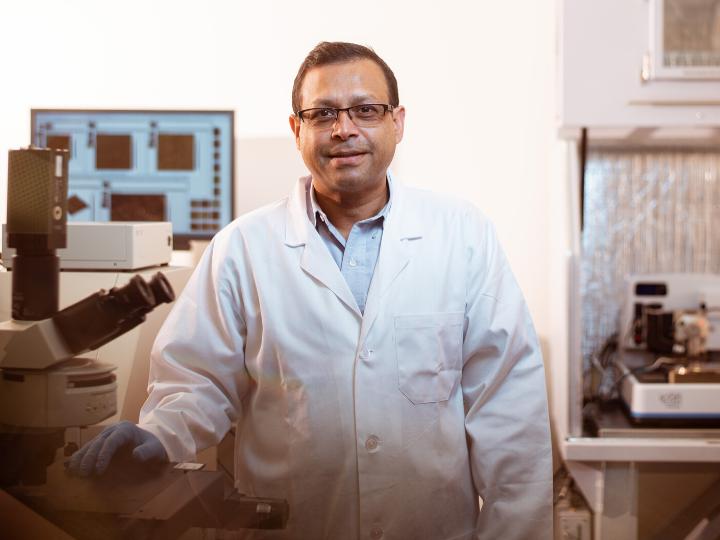Engineers produce eco-friendly polymers using material from shrimp, mushrooms and other organisms

Credit: University of Houston
Shrimp, lobsters and mushrooms may not seem like great tools for the battlefield, but three engineers from the University of Houston are using chitin – a derivative of glucose found in the cellular walls of arthropods and fungi – and 3D printing techniques to produce high-impact multilayered coatings that can protect soldiers against bullets, lasers, toxic gas and other dangers.
Although corn is better known as a sustainable, bio-based material, chitin offers promise as a commonly available material that could be processed and used in some products that now require petroleum-based plastics, said Alamgir Karim, Dow Chair Professor of chemical and biomolecular engineering.
“What if we could process these materials and get them to a certain level of performance, so we could do some really good things in the plastics world?” he asked. “They would be biodegradable by design, so they could decompose and return to Mother Nature.”
Karim, who also serves as director of the International Polymer & Soft Matter Center and of the materials engineering program at UH, is principal investigator on the project, funded by a $660,000 grant from the U.S. Department of Defense. Venkatesh Balan, assistant professor of engineering technology, and Megan Robertson, associate professor of chemical and biomolecular engineering, are co-principal investigators.
They are charged with developing tough, durable and antimicrobial multilayer films capable of resisting an impact from projectiles or lasers while simultaneously absorbing toxic gas. Karim said the work will also have applications beyond the military, potentially expanding its environmental benefits.
Chitin is the primary component of cell walls in fungi and the exoskeletons of arthropods, including crustaceans, insects and mollusks. It’s also found in fish scales. It can be harvested and processed to produce chitosan, or de-acetylated chitin, a fiber that is also produced and sold as a dietary supplement to treat obesity, high cholesterol, high blood pressure and Crohn’s disease. Chitosan is easier to handle than the brittle chitin.
Balan, whose lab produces bio-molecules for medical and industrial use, is using chemical and enzymatic processes to produce the chitosan molecules using crustacean shells. “We are trying to do the same thing with mushrooms,” he said, noting that mushrooms yield a more consistent degree of polymerization sustainably, helping to standardize production of chitin and then process it to become chitosan.
A stable source of chitosan polymers will be just the beginning. Robertson will determine how to alter the atomic composition at the surface of the chitosan in order to improve how it interfaces with the functional layers. Her research includes designing sustainable and biodegradable polymers derived from renewable resources.
That enhanced compatibility between the chitosan and the polymer will improve the coating’s ability to trap gas or absorb the impact from a projectile, she said.
That’s where Karim comes in – he is engineering a multilayer system that will be comprised of a hardened impact-resistant layer; an energy-absorbing crush layer reminiscent of the way modern cars are designed to crumple on impact, safeguarding the passenger capsule; a layer to absorb toxic gas, with charcoal nanoparticles dispersed in the chitosan; and a textile adhesion layer, which will bind the coating to canvas and other textiles.
That will involve 3D printing different chitin nanoparticles and chitosan-fabricated or reinforced crush-zone design structures and testing them to determine their ability to withstand an impact.
“It is a very good, environmentally friendly project,” Karim said, and one that will have applications for the automobile, construction and other industries.
###
Media Contact
Jeannie Kever
[email protected]
Original Source
https:/




